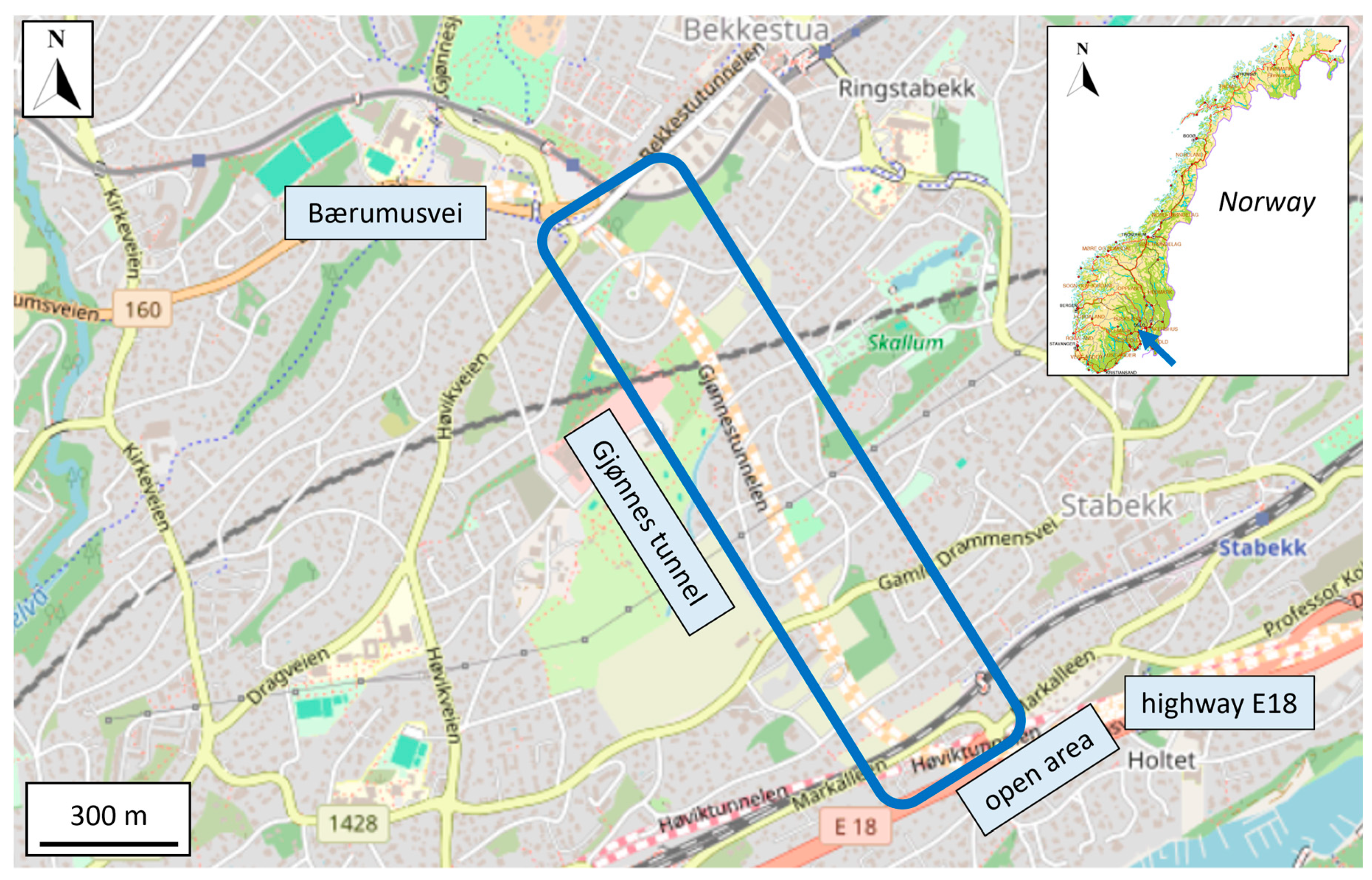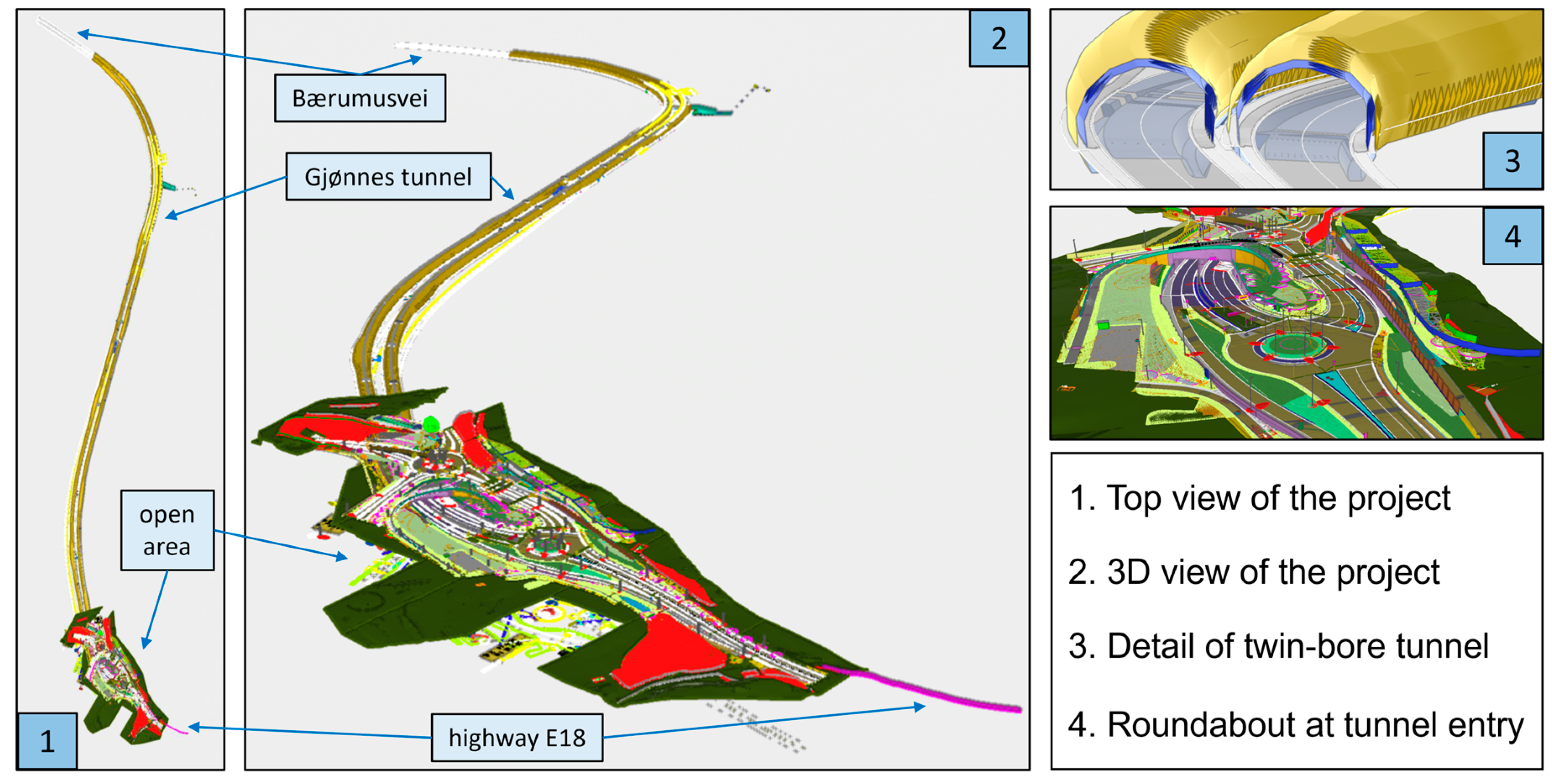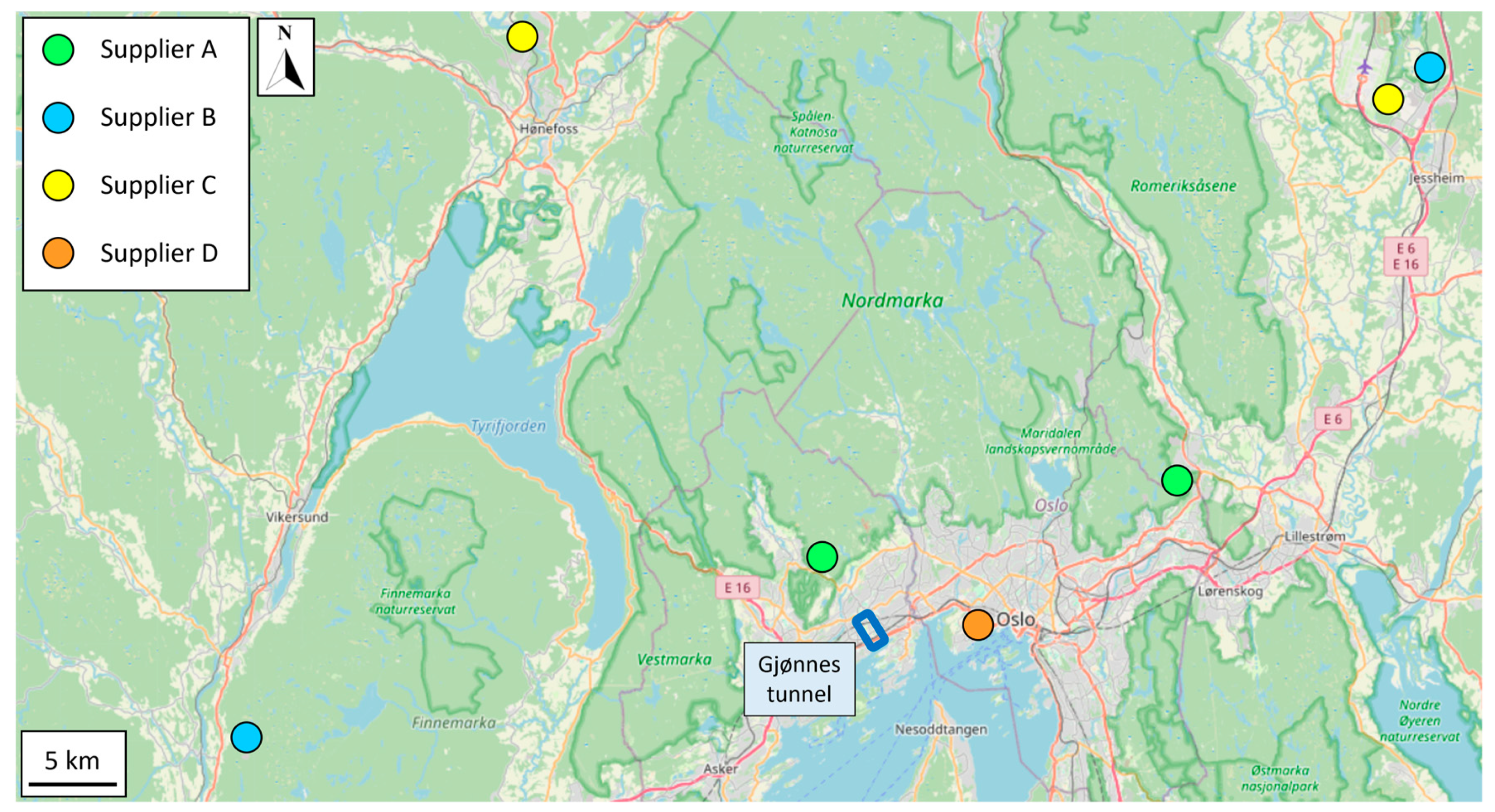Materials Carbon Budget in Road Projects: A Case Study from The Greater Oslo Region
Abstract
:1. Introduction
2. Methodology
2.1. Road Design and Digital Tools
2.2. Environmental Product Declaration
2.3. Case Study: “Gjønnes” Tunnel
3. Results and Discussion
4. Conclusions
Author Contributions
Funding
Data Availability Statement
Conflicts of Interest
References
- Thom, N. Principles of Pavement Engineering, 2nd ed.; ICE: London, UK, 2014. [Google Scholar]
- Haas, R.; Hudson, W.R. Pavement Asset Management, 1st ed.; Wiley: Hoboken, NJ, USA, 2015. [Google Scholar]
- Barbieri, D.M.; Lou, B.; Passavanti, M.; Hui, C.; Lessa, D.A.; Maharaj, B.; Banerjee, A.; Wang, F.; Chang, K.; Naik, B.; et al. Survey data regarding perceived air quality in Australia, Brazil, China, Ghana, India, Iran, Italy, Norway, South Africa, United States before and during COVID-19 restrictions. Data Br. 2020, 32, 106169. [Google Scholar] [CrossRef]
- Wiedenhofer, D.; Baumgart, A.; Matej, S.; Virág, D.; Kalt, G.; Lanau, M.; Tingley, D.D.; Liu, Z.; Guo, J.; Tanikawa, H.; et al. Mapping and modelling global mobility infrastructure stocks, material flows and their embodied greenhouse gas emissions. J. Clean. Prod. 2024, 434, 139742. [Google Scholar] [CrossRef]
- Yoro, K.O.; Daramola, M.O. CO2 emission sources; greenhouse gases, and the global warming effect. In Advances in Carbon Capture, 1st ed.; Rahimpour, M.R., Farsi, M., Makarem, M.A., Eds.; Elsevier: Amsterdam, The Netherlands, 2020; pp. 3–28. [Google Scholar]
- Regjeringen, Klimaendringer Og Norsk Klimapolitikk. 2024. Available online: https://www.regjeringen.no/no/tema/klima-og-miljo/innsiktsartikler-klima-miljo/klimaendringer-og-norsk-klimapolitikk/id2636812/ (accessed on 1 June 2024).
- Bryce, J.; Brodie, S.; Parry, T.; Lo Presti, D. A systematic assessment of road pavement sustainability through a review of rating tools. Resour. Conserv. Recycl. 2017, 120, 108–118. [Google Scholar] [CrossRef]
- Sha, A.; Jiang, W.; Wang, W.; Lou, B.; Cao, Y.; Jia, M. Design and prospect of new pavement materials for smart road. Chin. Sci. Bull. 2020, 65, 3259–3269. [Google Scholar] [CrossRef]
- Liu, N.; Wang, Y.; Bai, Q.; Liu, Y.; Wang, P.; Xue, S.; Yu, Q.; Li, Q. Road life-cycle carbon dioxide emissions and emission reduction technologies: A review. J. Traffic Transp. Eng. (Engl. Ed.) 2022, 9, 532–555. [Google Scholar] [CrossRef]
- Solomon, S.; Plattner, G.K.; Knutti, R.; Friedlingstein, P. Irreversible climate change due to carbon dioxide emissions. Proc. Natl. Acad. Sci. USA 2009, 106, 1704–1709. [Google Scholar] [CrossRef] [PubMed]
- Narassimhan, E.; Gallagher, K.S.; Koester, S.; Alejo, J.R. Carbon pricing in practice: A review of existing emissions trading systems. Clim. Policy 2018, 18, 967–991. [Google Scholar] [CrossRef]
- Rietbergen, M.G.; Blok, K. Assessing the potential impact of the CO2 performance ladder on the reduction of carbon dioxide emissions in the Netherlands. J. Clean. Prod. 2013, 52, 33–45. [Google Scholar] [CrossRef]
- Anthonissen, J.; Van Troyen, D.; Braet, J.; Van Den Bergh, W. Using carbon dioxide emissions as a criterion to award road construction projects: A pilot case in Flanders. J. Clean. Prod. 2015, 102, 96–102. [Google Scholar] [CrossRef]
- EAPA. Asphalt in Figures 2022; EAPA: Brussels, Belgium, 2022. [Google Scholar]
- Thives, L.P.; Ghisi, E. Asphalt mixtures emission and energy consumption: A review. Renew. Sustain. Energy Rev. 2017, 72, 473–484. [Google Scholar] [CrossRef]
- Praticò, F.G. Metrics for management of asphalt plant sustainability. J. Constr. Eng. Manag. 2017, 143, 04016116. [Google Scholar] [CrossRef]
- Barbieri, D.M.; Hoff, I.; Mørk, M.B.E. Innovative stabilization techniques for weak crushed rocks used in road unbound layers: A laboratory investigation. Transp. Geotech. 2019, 18, 132–141. [Google Scholar] [CrossRef]
- Barbieri, D.M.; Hoff, I.; Mørk, M.B.E. Organosilane and lignosulfonate as innovative stabilization techniques for crushed rocks used in road unbound layers. Transp. Geotech. 2020, 22, 100308. [Google Scholar] [CrossRef]
- Attahiru, Y.B.; Aziz, M.M.A.; Kassim, K.A.; Shahid, S.; Wan Abu Bakar, W.A.; NSashruddin, T.F.; Rahman, F.A.; Ahamed, M.I. A review on green economy and development of green roads and highways using carbon neutral materials. Renew. Sustain. Energy Rev. 2019, 101, 600–613. [Google Scholar] [CrossRef]
- Perkins, S. Realizing the roads of the future. Proc. Natl. Acad. Sci. USA 2021, 118, e2024425118. [Google Scholar] [CrossRef] [PubMed]
- ISO 14044; Environmental Management—Life Cycle Assessment—Requirements and Guidelines. CEN: Brussels, Belgium, 2006.
- ISO 14040; Environmental Management—Life Cycle Assessment—Principles and Framework. CEN: Brussels, Belgium, 2006.
- Inyim, P.; Pereyra, J.; Bienvenu, M.; Mostafavi, A. Environmental assessment of pavement infrastructure: A systematic review. J. Environ. Manag. 2016, 176, 128–138. [Google Scholar] [CrossRef] [PubMed]
- Aryan, Y.; Dikshit, A.K.; Shinde, A.M. A critical review of the life cycle assessment studies on road pavements and road infrastructures. J. Environ. Manag. 2023, 336, 117697. [Google Scholar] [CrossRef] [PubMed]
- Azarijafari, H.; Yahia, A.; Ben Amor, M. Life cycle assessment of pavements: Reviewing research challenges and opportunities. J. Clean. Prod. 2016, 112, 2187–2197. [Google Scholar] [CrossRef]
- Santero, N.J.; Masanet, E.; Horvath, A. Life-cycle assessment of pavements. Part I: Critical review. Resour. Conserv. Recycl. 2011, 55, 801–809. [Google Scholar] [CrossRef]
- Plati, C. Sustainability factors in pavement materials, design, and preservation strategies: A literature review. Constr. Build. Mater. 2019, 211, 539–555. [Google Scholar] [CrossRef]
- Hu, W.; Shu, X.; Huang, B. Sustainability innovations in transportation infrastructure: An overview of the special volume on sustainable road paving. J. Clean. Prod. 2019, 235, 369–377. [Google Scholar] [CrossRef]
- Barbieri, D.M.; Hoff, I.; Mørk, M.B.E. Mechanical assessment of crushed rocks rerived from tunnelling operations. In Sustainable Civil Infrastructures; Cheng, W.-C., Yang, J., Wang, J., Eds.; Springer: Hangzhou, China, 2019; pp. 225–241. [Google Scholar] [CrossRef]
- Barbieri, D.M.; Hoff, I.; Mork, H. Laboratory investigation on unbound materials used in a highway with premature damage. In Proceedings of the 10th International Conference on the Bearing Capacity of Roads, Railways and Airfields (BCRRA 2017), Athens, Greece, 28–30 June 2017; Loizos, A., Al-Qadi, I.L., Scarpas, A.T., Eds.; Airfields, Taylor & Francis: Athens, Greece, 2017; pp. 101–108. [Google Scholar] [CrossRef]
- NPRA. Håndbok N200 Vegbygging; Vegdirektoratet: Oslo, Norway, 2022. [Google Scholar]
- Barbieri, D.M.; Lou, B.; Dyke, R.J.; Wang, X.; Chen, H.; Shu, B.; Gazder, U.; Horpibulsuk, S.; Tingle, J.S.; Hoff, I. Design and sustainability analyses of road base layers stabilized with traditional and nontraditional additives. J. Clean. Prod. 2022, 372, 133752. [Google Scholar] [CrossRef]
- Eastman, C.; Teicholz, P.; Sacks, R.; Liston, K. BIM Handbook: A Guide to Building Information Modeling for Owners, Managers, Designers, Engineers and Contractors, 1st ed.; Wiley: Hoboken, NJ, USA, 2008. [Google Scholar]
- Volk, R.; Stengel, J.; Schultmann, F. Building Information Modeling (BIM) for existing buildings—Literature review and future needs. Autom. Constr. 2014, 38, 109–127. [Google Scholar] [CrossRef]
- Bazán, Á.M.; Alberti, M.G.; Álvarez, A.A.; Trigueros, J.A. New perspectives for BIM usage in transportation infrastructure projects. Appl. Sci. 2020, 10, 7072. [Google Scholar] [CrossRef]
- Costin, A.; Adibfar, A.; Hu, H.; Chen, S.S. Building Information Modeling (BIM) for transportation infrastructure—Literature review, applications, challenges, and recommendations. Autom. Constr. 2018, 94, 257–281. [Google Scholar] [CrossRef]
- Bui, N.; Merschbrock, C.; Munkvold, B.E.; Hjelseth, E. Role of an innovation community in supporting BIM deployment: The case of buildingsmart Norway. WIT Trans. Built Environ. 2019, 192, 329–342. [Google Scholar] [CrossRef]
- Lassen, A.K.; Hjelseth, E.; Tollnes, T. Enhancing learning outcomes by introducing BIM in civil engineering studies –experiences from a university college in Norway. Int. J. Sustain. Dev. Plan. 2018, 13, 62–72. [Google Scholar] [CrossRef]
- NPRA. Håndbok V770 Modellgrunnlag; Vegdirektoratet: Oslo, Norway, 2015. [Google Scholar]
- Bane NOR. Krav Til Informasjonsmodellering (KIM). 2022. Available online: https://www.banenor.no/kim (accessed on 1 June 2024).
- Trimble. Trimble Novapoint. 2024. Available online: https://www.novapoint.com/products/novapoint (accessed on 1 June 2024).
- ISO 14025; Environmental labels and Declarations—Type III Environmental Declarations—Principles and Procedures. CEN: Brussels, Belgium, 2006.
- EPD-Norway. 2024. Available online: https://www.epd-norge.no/ (accessed on 1 June 2024).
- ISO 15804; Sustainability of Construction Works. Environmental Product Declarations. Core Rules for the Product Category of Construction Products. CEN: Brussels, Belgium, 2019.
- ISO 21930; Sustainability in Buildings and Civil Engineering Works. Core Rules for Environmental Product Declarations of Construction Products and Services. CEN: Brussels, Belgium, 2017.
- NPRA. Bruk av VegLCA. 2024. Available online: https://www.vegvesen.no/fag/fokusomrader/klima-miljo-og-omgivelser/utslipp-av-klimagasser/bruk-av-veglca/ (accessed on 1 June 2024).
- LCA.no. 2024. Available online: https://support.lca.no/ (accessed on 1 June 2024).
- Eurobitume. The Bitumen Life Cycle Inventory. 2024. Available online: https://eurobitume.eu/bitumen-life-cycle-inventory/ (accessed on 1 June 2024).
- Ecoinvent. Ecoinvent Database. 2024. Available online: https://ecoinvent.org/database/ (accessed on 1 June 2024).
- NPRA. Anleggsarbeider Fornebukrysset-Strand—Entreprise E102. 2024. Available online: https://www.vegvesen.no/vegprosjekter/europaveg/e18vestkorridoren/lysaker-ramstadsletta/fornebukrysset-strand-e102/ (accessed on 1 June 2024).
- NPRA. Gjønnestunnelen—Entreprise E105. 2024. Available online: https://www.vegvesen.no/vegprosjekter/europaveg/e18vestkorridoren/lysaker-ramstadsletta/gjonnestunnelen---e105/ (accessed on 1 June 2024).
- NPRA. Håndbok N500 Vegtunneler; Vegdirektoratet: Oslo, Norway, 2024. [Google Scholar]
- OpenStreetMap. 2024. Available online: www.openstreetmap.org (accessed on 1 June 2024).
- ISO 13108-1; Bituminous Mixtures. Material Specifications. Part 1: Asphalt Concrete. CEN: Brussels, Belgium, 2016.
- ISO 13108-21; Bituminous Mixtures. Material Specifications. Part 21: Factory Production Control. CEN: Brussels, Belgium, 2016.
- Hanson, C.; Noland, R.; Cavale, K. Life-cycle greenhouse gas emissions of materials used in road construction. Transp. Res. Rec. 2012, 2287, 174–181. [Google Scholar] [CrossRef]
- Peng, B.; Cai, C.; Yin, G.; Li, W.; Zhan, Y. Evaluation system for CO2 emission of hot asphalt mixture. J. Traffic Transp. Eng. (Engl. Ed.) 2015, 2, 116–124. [Google Scholar] [CrossRef]





| Road Layer | Construction Material | Thickness (cm) | Quantity (ton) |
|---|---|---|---|
| Wearing | AC 16 PMB | 5 | 11,549 |
| Binder | AC 16 PMB | 5 | 11,549 |
| Base | AG 16 | 12 | 34,959 |
| Subbase | Crushed rock 4/90 | 25 | 73,989 |
| Road Layer | Supplier A | Supplier B | Supplier C | Supplier D | ||||
|---|---|---|---|---|---|---|---|---|
| Emission Factor a | CO2 Emission b | Emission Factor a | CO2 Emission b | Emission Factor a | CO2 Emission b | Emission Factor a | CO2 Emission b | |
| Wearing | 37.40 | 432 | 46.90 | 542 | 26.30 | 304 | 35.89 | 414 |
| Binder | 37.40 | 432 | 46.90 | 542 | 26.30 | 304 | 35.89 | 414 |
| Base | 19.49 | 681 | 18.16 | 635 | 34.04 | 1 190 | 25.66 | 897 |
| Subbase | 2.32 | 171 | 2.11 | 156 | 2.68 | 198 | 2.34 | 173 |
| TOTAL | 1716 | 1874 | 1995 | 1899 | ||||
Disclaimer/Publisher’s Note: The statements, opinions and data contained in all publications are solely those of the individual author(s) and contributor(s) and not of MDPI and/or the editor(s). MDPI and/or the editor(s) disclaim responsibility for any injury to people or property resulting from any ideas, methods, instructions or products referred to in the content. |
© 2024 by the authors. Licensee MDPI, Basel, Switzerland. This article is an open access article distributed under the terms and conditions of the Creative Commons Attribution (CC BY) license (https://creativecommons.org/licenses/by/4.0/).
Share and Cite
Khair, M.; Strzalkowski, P.; Faizi, A.Q.; Barkal, M.G.; Fawakherji, I.; Lima, M.; Adeysey, M.; Barbieri, D.M.; Lou, B. Materials Carbon Budget in Road Projects: A Case Study from The Greater Oslo Region. Infrastructures 2024, 9, 132. https://doi.org/10.3390/infrastructures9080132
Khair M, Strzalkowski P, Faizi AQ, Barkal MG, Fawakherji I, Lima M, Adeysey M, Barbieri DM, Lou B. Materials Carbon Budget in Road Projects: A Case Study from The Greater Oslo Region. Infrastructures. 2024; 9(8):132. https://doi.org/10.3390/infrastructures9080132
Chicago/Turabian StyleKhair, Moa, Patryk Strzalkowski, Abdul Qaher Faizi, Mustafa Gilo Barkal, Ibrahim Fawakherji, Martina Lima, Mohammed Adeysey, Diego Maria Barbieri, and Baowen Lou. 2024. "Materials Carbon Budget in Road Projects: A Case Study from The Greater Oslo Region" Infrastructures 9, no. 8: 132. https://doi.org/10.3390/infrastructures9080132






